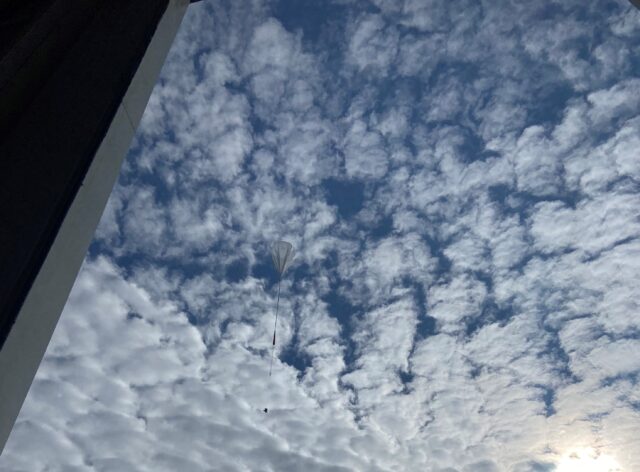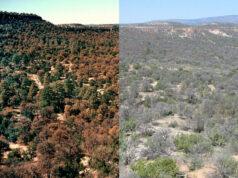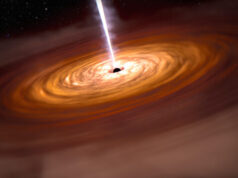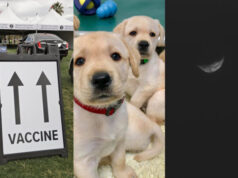UArizona Team Creates Instrument to Study Invisible Clouds that Warm Earth
The doctoral student leading the project ushered the instrument from concept to launch into near space. The instrument will eventually be deployed onboard a NASA CubeSat to monitor invisible clouds.
Mikayla Mace Kelley
Today
University Communications
IMG_1250.jpeg
Kira Hart Shanks’ instrument takes it first test flight upon a scientific balloon launched from Fort Sumner Municipal Airport in New Mexico.
Kira Hart Shanks
Science and Technology
College of Optical Sciences Experts Exploration Science Students
Media contact(s)
Researcher contact(s)
Kira Hart Shanks
James C. Wyant College of Optical Sciences
Find your dream job in the space industry. Check our Space Job Board »
Meredith Kupinski
James C. Wyant College of Optical Sciences
Invisible clouds can loom overhead. Related to thin and wispy cirrus clouds, they consist of ice crystals in the upper atmosphere but can’t be seen by the naked eye.
A University of Arizona doctoral student designed, built and launched into near space an instrument for detecting these invisible clouds. Defining the clouds’ shape, size, distribution and other characteristics is important for understanding their impact on Earth’s radiation budget – the amount of heat from the sun trapped or released by the Earth’s atmosphere – as well as forecasting future storms.
Kira Hart Shanks.jpg
Kira Hart Shanks
Kira Hart Shanks
Kira Hart Shanks, a fifth-year doctoral student in the James C. Wyant College of Optical Sciences, received a NASA Future Investigators grant to launch the device 1,000 feet into the atmosphere onboard a high-altitude balloon to demonstrate the instrument’s scientific capabilities. The launch took place in August in New Mexico. The instrument, called an infrared channeled spectropolarimeter, will eventually be launched into space on a NASA CubeSat, which is like a miniature satellite.
The goal is to create a global network of spectropolarimeters to monitor invisible clouds in the upper atmosphere. The instrument does so by detecting long wavelengths of infrared light, which humans perceive as heat, called thermal IR.
“We can’t see with our eyes, but it’s the light emitted by heat. All of us shine like lightbulbs in the thermal IR,” Hart Shanks said. “We’re looking at cirrus ice clouds. Depending on the shape, size and distribution of these clouds, they will reflect or transmit certain amounts of solar radiation. It’s important to understand how much makes it through these clouds and to the Earth’s surface. This information will inform everything from long-term climate forecasting to short-term weather forecasting.”
The instrument detects a polarimetric signal, or polarized light, which is light reflected from the invisible clouds when all the ice crystals are pointed in one direction. Like color and brightness, polarization is another property of light that is governed by the geometry of light waves. When the light encounters clouds in the atmosphere, the geometry of the light waves can change in response to the characteristics of the cloud.
“The polarimetric signal is important because it can tell you about the ice crystal structure,” said optical sciences research professor Meredith Kupinski, who is also Hart Shanks’ adviser. “As they say, there are no two snowflakes the same, but for ice crystals, different structure has consequences for the lifetime of the cloud, the precipitation and how much solar radiation the cloud is going to bounce back to space versus transmit to Earth’s surface. Thermal IR polarimetry won’t tell us everything about the optical properties of clouds, but it’s very useful for understanding the radiation budget problem and weather forecasting.”
Atmospheric models have postulated this polarized light signal in thermal IR, but the signal has never been successfully detected or measured until now – using a device made from easily sourced, off-the-shelf technology. Only one part was custom made, Hart Shanks said.
Experienced NASA engineers who were part of other science teams at the balloon launch tried to manage the UArizona team’s expectations by warning that high-altitude technology demonstrations often don’t work the first time. But ultimately, the first flight into near space was successful. Once the instrument is launched on a CubeSat, the team will have more control over the instrument and will be able to observe the same location multiple times since the instrument will be in orbit.
“It’s not typical for a doctoral student to progress a technology from design to fabrication to assembly, then to deployment and even analysis of field measurements,” Kupinski said.
“I had such supportive people and resources here at the University of Arizona,” Hart Shanks said. “It wouldn’t have been possible anywhere else.”
The work has involved many other people at UArizona, including optical sciences research professor Chang Jin Oh. He and his team in the Optical Engineering and Fabrication Facility led the optomechanical design of the instrument and provided instrument assembly support. Optics graduate student Jeremy Parkinson led the mechanical and electrical design of the balloon payload, and the 2020-2021 Undergraduate Engineering Interdisciplinary Capstone team helped to select the parts for the instrument and modeled how the parts would perform in the extreme environment of near space.
“The University of Arizona team did an amazing job by not only maneuvering through the pandemic with lab work but also successfully launching this infrared polarimeter on a high-altitude balloon with good science data acquired,” said Dong Wu, principal investigator for NASA’s Submillimeter Wave and Long Wave Infrared Polarimeter, or SWIRP, project, which includes Hart Shanks’ IR polarimeter and two instruments made by other entities.
“As a NASA scientist, I couldn’t be more excited than this achievement, as many agency’s projects are severely impacted by COVID,” Wu said. “Through this collaboration with the University of Arizona faculties and students, I observed one of the real driving forces and the great future for this country.”











